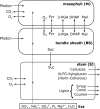A mass and charge balanced metabolic model of Setaria viridis revealed mechanisms of proton balancing in C4 plants
- PMID: 31248364
- PMCID: PMC6598292
- DOI: 10.1186/s12859-019-2941-z
A mass and charge balanced metabolic model of Setaria viridis revealed mechanisms of proton balancing in C4 plants
Abstract
Background: C4 photosynthesis is a key domain of plant research with outcomes ranging from crop quality improvement, biofuel production and efficient use of water and nutrients. A metabolic network model of C4 "lab organism" Setaria viridis with extensive gene-reaction associations can accelerate target identification for desired metabolic manipulations and thereafter in vivo validation. Moreover, metabolic reconstructions have also been shown to be a significant tool to investigate fundamental metabolic traits.
Results: A mass and charge balance genome-scale metabolic model of Setaria viridis was constructed, which was tested to be able to produce all major biomass components in phototrophic and heterotrophic conditions. Our model predicted an important role of the utilization of NH[Formula: see text] and NO[Formula: see text] ratio in balancing charges in plants. A multi-tissue extension of the model representing C4 photosynthesis was able to utilize NADP-ME subtype of C4 carbon fixation for the production of lignocellulosic biomass in stem, providing a tool for identifying gene associations for cellulose, hemi-cellulose and lignin biosynthesis that could be potential target for improved lignocellulosic biomass production. Besides metabolic engineering, our modeling results uncovered a previously unrecognized role of the 3-PGA/triosephosphate shuttle in proton balancing.
Conclusions: A mass and charge balance model of Setaria viridis, a model C4 plant, provides the possibility of system-level investigation to identify metabolic characteristics based on stoichiometric constraints. This study demonstrated the use of metabolic modeling in identifying genes associated with the synthesis of particular biomass components, and elucidating new role of previously known metabolic processes.
Keywords: Ammonium and nitrate usage; Bioenergy grasses; C4 photosynthesis; Gene association; Genome-scale metabolic network model; Lignocellulosic biomass; Mass and charge balance; Millet; Setaria viridis.
Conflict of interest statement
The authors declare that they have no competing interests.
Figures




Similar articles
-
Genomic dissection and expression analysis of stress-responsive genes in C4 panicoid models, Setaria italica and Setaria viridis.J Biotechnol. 2020 Jul 20;318:57-67. doi: 10.1016/j.jbiotec.2020.05.007. Epub 2020 May 17. J Biotechnol. 2020. PMID: 32433921
-
Metabolic modelling revealed source-sink interactions between four segments of Setaria viridis leaves.J Biosci. 2023;48:26. J Biosci. 2023. PMID: 37539551
-
Metabolic Reconstruction of Setaria italica: A Systems Biology Approach for Integrating Tissue-Specific Omics and Pathway Analysis of Bioenergy Grasses.Front Plant Sci. 2016 Aug 10;7:1138. doi: 10.3389/fpls.2016.01138. eCollection 2016. Front Plant Sci. 2016. PMID: 27559337 Free PMC article.
-
Setaria viridis and Setaria italica, model genetic systems for the Panicoid grasses.J Exp Bot. 2011 May;62(9):3031-7. doi: 10.1093/jxb/err096. Epub 2011 Mar 31. J Exp Bot. 2011. PMID: 21459768 Review.
-
Foxtail millet: a model crop for genetic and genomic studies in bioenergy grasses.Crit Rev Biotechnol. 2013 Sep;33(3):328-43. doi: 10.3109/07388551.2012.716809. Epub 2012 Sep 18. Crit Rev Biotechnol. 2013. PMID: 22985089 Review.
Cited by
-
A multi-organ maize metabolic model connects temperature stress with energy production and reducing power generation.iScience. 2023 Nov 7;26(12):108400. doi: 10.1016/j.isci.2023.108400. eCollection 2023 Dec 15. iScience. 2023. PMID: 38077131 Free PMC article.
-
A multi-organ metabolic model of tomato predicts plant responses to nutritional and genetic perturbations.Plant Physiol. 2022 Mar 4;188(3):1709-1723. doi: 10.1093/plphys/kiab548. Plant Physiol. 2022. PMID: 34907432 Free PMC article.
-
Compartmentalization of metabolism between cell types in multicellular organisms: a computational perspective.Curr Opin Syst Biol. 2022 Mar;29:100407. doi: 10.1016/j.coisb.2021.100407. Epub 2021 Nov 14. Curr Opin Syst Biol. 2022. PMID: 35224313 Free PMC article.
-
Toward mechanistic modeling and rational engineering of plant respiration.Plant Physiol. 2023 Apr 3;191(4):2150-2166. doi: 10.1093/plphys/kiad054. Plant Physiol. 2023. PMID: 36721968 Free PMC article.
-
A diel multi-tissue genome-scale metabolic model of Vitis vinifera.PLoS Comput Biol. 2024 Oct 10;20(10):e1012506. doi: 10.1371/journal.pcbi.1012506. eCollection 2024 Oct. PLoS Comput Biol. 2024. PMID: 39388487 Free PMC article.
References
-
- Rao PP, Birthal P, Reddy BV, Rai K, Ramesh S. Diagnostics of sorghum and pearl millet grains-based nutrition in india. Int Sorghum Millets Newsl. 2006;47:93–96.
-
- Garí JA. International Workshop on Fonio, Food Security and Livelihood Among the Rural Poor in West Africa. Bamako: IPGRI/IFAD; 2002. Review of the african millet diversity.
-
- Rawson H, Begg J, Woodward R. The effect of atmospheric humidity on photosynthesis, transpiration and water use efficiency of leaves of several plant species. Planta. 1977;134(1):5–10. - PubMed
MeSH terms
Substances
LinkOut - more resources
Full Text Sources
Miscellaneous

